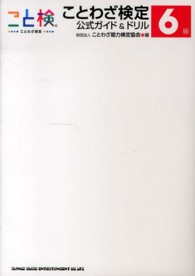- ホーム
- > 洋書
- > 英文書
- > Science / Mathematics
基本説明
Textbook.
Full Description
An overall view of the vast spectrum of knowledge needed by practicing rocket scientists and engineers, Introduction to Rocket Science and Engineering presents the history and basics of rocket theory, design, experimentation, testing, and applications. It covers an array of fields, from advanced mathematics, chemistry, and physics to logistics, systems engineering, and politics.The text begins with a discussion on the discovery and development of rockets as well as the basic principles governing rockets and rocket science. It explains why rockets are needed from economic, philosophical, and strategic standpoints and looks at why the physics of the universe forces us to use rockets to complete certain activities. Exploring how rockets work, the author covers the concepts of thrust, momentum, impulse, and the rocket equation, along with the rocket engine, its components, and the physics involved in the generation of the propulsive force. He also presents several different types of rocket engines and discusses the testing of rocket components, subsystems, systems, and complete products. The final chapter stresses the importance of rocket scientists and engineers to think of the unusual, unlikely, and unthinkable when dealing with the complexities of rocketry.Taking students through the process of becoming a rocket scientist or engineer, this text supplies a hands-on understanding of the many facets of rocketry. It provides the ideal foundation for students to continue on their journey in rocket science and engineering.
Contents
What Are Rockets? The History of RocketsRockets of the Modern EraRocket Anatomy and NomenclatureWhy Are Rockets Needed? Missions and PayloadsTrajectoriesOrbitsOrbit Changes and ManeuversBallistic Missile TrajectoriesHow Do Rockets Work? ThrustSpecific ImpulseWeight Flow RateTsiolkovsky's Rocket EquationStagingRocket Dynamics, Guidance, and ControlHow Do Rocket Engines Work? The Basic Rocket EngineThermodynamic Expansion and the Rocket NozzleExit VelocityRocket Engine Area Ratio and LengthsRocket Engine Design ExampleAre All Rockets the Same? Solid Rocket EnginesLiquid Propellant Rocket EnginesHybrid Rocket EnginesElectric Rocket EnginesNuclear Rocket EnginesSolar Rocket EnginesPhoton-Based EnginesHow Do We Test Rockets? The Systems Engineering Process and Rocket DevelopmentMeasuring ThrustPressure Vessel TestsShake 'n Bake TestsDrop and Landing TestsEnvironment TestsDestructive TestsModeling and SimulationRoll-Out TestFlight TestsAre We Thinking Like Rocket Scientists and Engineers?Weather CockingFuel SloshingPropellant VorticityTornadoes and OverpassesFlying Foam DebrisMonocoqueThe Space Mission Analysis and Design ProcessBack to the MoonSuggested Reading for Rocket Scientists and EngineersIndexA Chapter Summary and Exercises appear at the end of each chapter.







